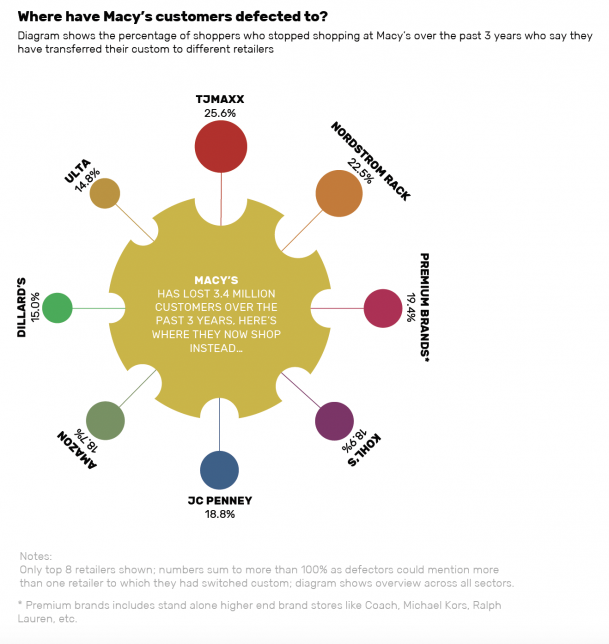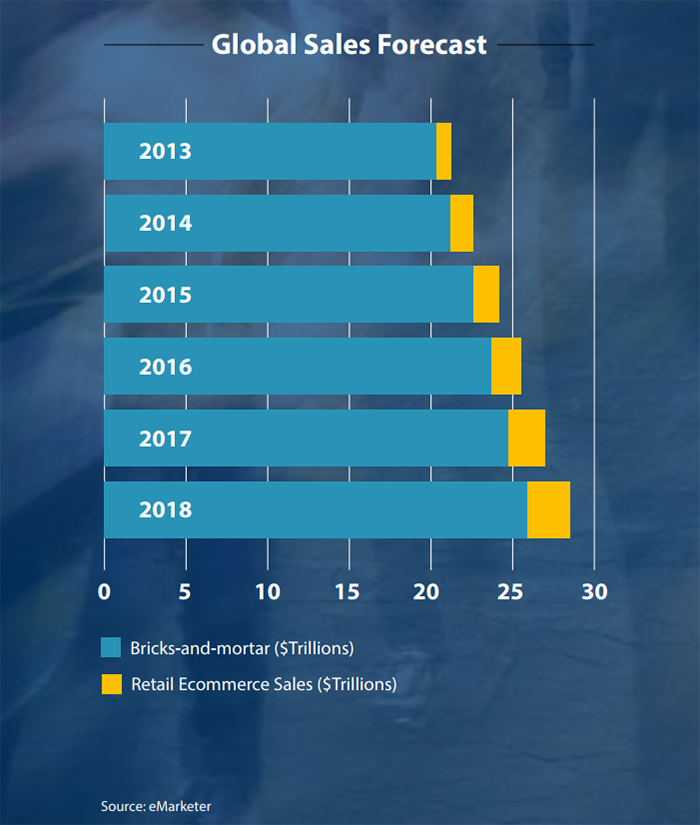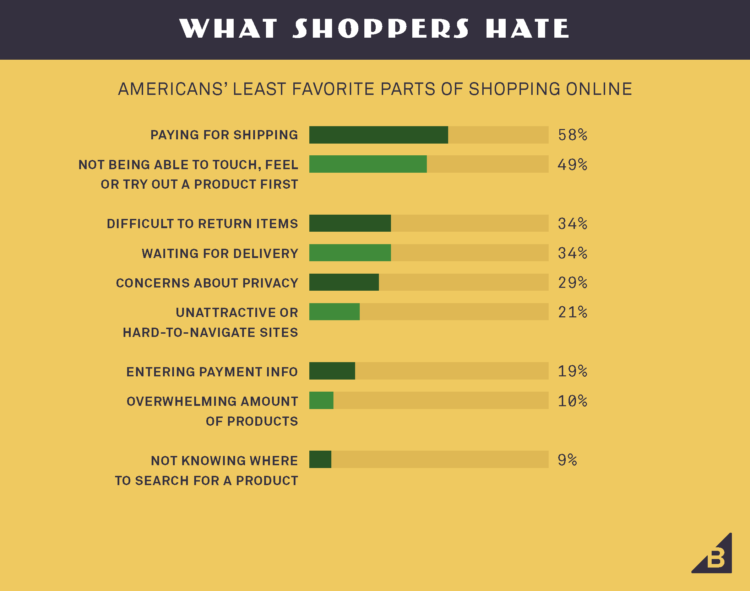Click-and-Mortar: Why Mixing Bricks and Clicks is the Future of Retail
Is it still viable to juxtapose eCommerce with brick-and-mortar retail? Instead, bring bricks and clicks together for an omnichannel approach.
As digital channels are taking over, more and more retailers shut their brick-and-mortar stores and invest in ecommerce solutions instead. These stories keep coming, and mass media simply love it. Going through big retail players’ earning announcements creates a sense of an utmost urgency. “Look at Macy’s!” they say. Or Nordstrom, or Target. Have their customers really shifted their loyalty to eCommerce?
Indeed, let’s take a look at Macy’s:
 Source: blog.vendhq.com
Source: blog.vendhq.com
What we can see here is that only 18% of Macy’s customers have turned to eCommerce (Amazon), whereas a much larger fraction of lost customers has chosen other retail, very much brick-and-mortar, stores.
ECommerce is certainly the fastest growing retail sector. Online sales are experiencing a 15% YoY increase, rapidly outperforming brick-and-mortar, which has stood still at a sheer 2.2%. And here is a forecast for online retail’s projected growth by 2020:
However, the opportunities for brick-and-mortars are not yet exhausted. According to eMarketer, bricks are nowhere near the state of death or even a significant harm. With the overall increase in sales, both segments, online and offline, are expected to grow.

Yet, in the eyes of consumers, bricks provide a different value proposition. Thus, that “drama show,” as boxers often name their battles, between bricks and clicks might not be the right way of looking at the state of today’s retail. Instead, a balanced and, if you will, a diplomatic approach is the key to succeeding in our modern race for customer acquisition and retention.
A lot has already been said and written on the perks of online sales, and the value of having an online store is quite clear. Thus, let’s focus our attention on the value of click-and-mortar stores, an omnichannel approach that can help retailers survive.
Bricks vs. Clicks: a Look at Consumer Behaviour
In the fourth quarter of 2016, eCommerce sales accounted for mere 8.3% of total retail sales in the US (Census), with approximately half of these sales belonging to stores that are both brick and click. And while many bricks are rapidly trying to digitalize (Walmart, for instance), eCommerce sites are taking the opposite direction. ECommerce giants like Amazon, or smaller online stores like Bonobos or Warby Parker, go click-and-mortar opening physical stores, showrooms, and studios.
The 2015 TimeTrade survey discovered that 85 percent of customers still prefer traditional shopping: they can see, touch, and feel the product prior to making a purchasing decision. Interestingly, according to CBRE, 70% of Millennials and 77% of Gen Z’s give their preference to a retail store experience. Thus, the most active online shoppers are the baby boomers, and they can and do spend more.
The biggest advantage of online shopping, though, often comes with lower prices and higher convenience. After all, not many retailers can offer shoe shopping in a physical store at 3 am. While we will look at pricing in more detail in the next section, the convenience aspect should be taken carefully.
The same 2015 TimeTrade survey revealed that 36% of consumers dislike the shipping wait time, and 90% claimed that they often need some extra encouragement from shopping assistants to make a purchase. However, the latter issue can now be tackled with the implementation of chatbots that act as virtual assistants. And the more advanced they get, the better they imitate that experience.
Moreover, keep in mind that these trends are not consistent across various industry segments: what’s true for an apparel segment, is not necessarily the case for commoditized or electronics goods. It takes much less of a feel-and-touch desire to pick a kitchen appliance than when shopping for an evening gown. In recent years, we’ve witnessed a game-changing vanishing of big names within this sector. Moreover, in these cases, customers are more prone to showrooming, or looking at the product in-store, and then finding it at a lower cost online.
Bricks vs. Clicks: Brand Awareness
For those eCommerce sites that have been around for a while now, it is much easier to sell online, too.
Online retail, as was (and, probably, is) the case with its offline counterpart, has become overcrowded and, frankly, very expensive. In order to get your website out there, you have to bid on keywords against eCommerce giants like Amazon and some offline but digitized retailers, to make sure that your website is out there on the first page of search results. Although not completely impossible, both organic and paid search is becoming more and more of a game for those who can afford to invest more in SEO and in digital marketing. There’s certainly a lot of strategies one can use to stand out, but they require money and time, things that eCommerce is supposed to spare you from.
According to L2 Inc, Macy’s and Nordstrom spent approximately $6.4 million and $4 million, respectively, on paid advertising, bidding on the top thousand apparel-related keywords. Not everyone can compete with that.
Moreover, having a physical presence is not merely an indication of brand authority or legitimacy or success. It is also something that can be boosted by Google that works tirelessly on balancing up that giant vs. newcomers gap. Businesses that have a physical presence can benefit from some prime real estate in SERPs thanks to ability to appear in local search and be identified on Google Maps, and even gain some authority through My Business listing that showcases reviews, photos and product availability in-store. So yes, a digital presence is a must, but disregarding and claiming bricks as obsolete would simply be a wrong thing to do.
Bricks vs. Clicks: Conversions
When it comes to conversions, offline stores show higher conversion rates in relation to their online counterparts.
It does make sense, for it is harder to refuse to buy something you’ve already encountered with and, maybe, tried on. Moreover, online sales are really suffering from cart abandonment. Impulsive purchase that happens so often in stores is the equivalent of adding something to an online cart. However, with online you can always close the website or revise your purchase list much closer than when in-store.
 Source: smallbiztrends.com
Source: smallbiztrends.com
Moreover, 28% of online purchasers abandon their carts if the shipping seems too costly. And, at least a third of all items purchased online gets returned in comparison with 8.89% of offline purchases.
Bricks vs. Clicks: Price
Price transparency is one of the biggest advantages of online sales. ECommerce provides consumers with more control over what they buy and at what price.
Harvard Business Review has recently revealed that the competitive edge (price) of online shopping comes from unsustainably low-profit margins. John Idol, CEO of Michael Kors, has admitted that the company's online sales profits were being outweighed by free delivery, return, and packaging expenditures.
The pricing advantage is especially relevant to branded items that people are already aware of. Thus, these products are definitely better to be sold and bought online. And here is when the showrooming concept has been detrimental to offline sales. But it should be noted that showrooming occurs alongside webrooming, the opposite process when people search online first, and then go and buy the desired product in the store. In fact, two-thirds of eCommerce shoppers are webrooming, while half of brick-and-mortar customers are showrooming.
The Omnichannel Approach is the Key
So what do you do to make sure you aren’t losing a big number of customers both online and offline due to all the challenges mentioned above? An omnichannel strategy seems to be the most plausible answer. After all, it includes the perks of both worlds, online and offline. Some have claimed that traditional retail plus eCommerce is a “match made in heaven.”
Digital think tank L2 has proclaimed a “death of pureplay retail” when offline retail merchants are investing in online merchants, as the online-only retail model becomes outdated. Amazon has already opened its first brick-and-mortar extension. And many other click merchants have followed. In fact, in the last few years, about 20 online businesses in the US have established a physical presence for better product marketing, building closer ties with customers and… enhancing online traffic and sales. The opposite trend also takes place: 38% of all retail sales are heavily triggered by any prior customer interaction with the company’s online presence - every $0.64 of each dollar spent in retail stores is influenced by that online contact.
Current technologies already offer some know-hows on integrating online retail with offline and vice-versa. And it all goes far beyond well-known “arrange an in-store pick-up,” “check sizes,” or “offer a wider product selection” techniques. Technology, and eCommerce development services precisely, can now personalize, send out geolocation-based promotions using GPS, and much much more. And those who are willing to take advantage of these new technologies will be able to bridge the gap between online and offline retail experience, which is the only way (for now) to gain a competitive edge in the fiercely competitive retail market.
WANT TO START A PROJECT?
It’s simple!